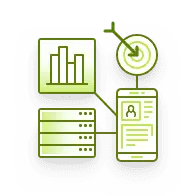Unlock Dropshipping for Offline Retailers
February 14, 2022 By Yana Persky

Ever wondered why dropshipping is not practiced by brick-and-mortar retailers without an online presence?
The excerpt below is taken from communications we had recently with one of the largest manufacturers and distributors in the US beauty industry.
“Our B2B buyers are placing orders via Pepperi’s B2B eCommerce portal. However, most of them do not sell online and have a salon or a brick-and-mortar retail location only. The product assortment they are selling is limited and very often they experience stockouts. Is there any way we can offer a “dropshipping” business model for their customers, to increase exposure and expand sales channels?”
By definition, dropshipping is a business model for online stores that typically do not hold any of the products in stock. Indeed, for years we have been witnessing how manufacturers and distributors drop-ship orders on behalf of online retailers directly to private customers.
Drop shipments are available from online divisions of Macy’s, Nordstrom, Kohl’s, Target, Lowe’s, Best Buy, REI, Chewy, DSW, Wayfair and others. By leaning into drop shipments, Nordstrom has the potential to extend its online selection to 20 times that of its physical locations, up from three times now. Over a quarter of online transactions at Nordstrom’s Anniversary Sale in August 2020 were fulfilled by drop ship.
Benefits of Dropshipping
Dropshipping has become a lucrative market, with 33% of online retailers adopting it as their primary method of order fulfillment. It was valued at US$ 162.44 billion in 2019 and is projected to grow at a CAGR of 18.3% and to reach US$ 591.77 billion by 2027.
It is estimated that 25% of retail sales will be made online by 2024. Although this marks a significant growth in online buying, it also implies that 75% of purchases will still be performed in a physical store.
Despite the fact that many offline businesses are adopting an omnichannel approach, there are still numerous brick-and-mortar stores that are opposed to, or delaying, the transition. According to a Visual Objects study of over 500 small businesses, only a year ago, 40% of SMBs did not have a website, and another 28% said they were unlikely to build one in the future.
Well, the good news is that the dropshipping market is making inroads into brick-and mortar space and presents a huge potential and an additional source of revenue for manufacturers and distributors serving merchants without an online presence.
According to an IHL Group study, retailers are missing out on nearly $1 trillion in sales because they do not have in stock what customers want to buy in their stores. According to a survey by iVend Retail, 67.3% of people say they leave a store empty-handed because they could not find what they needed, and 66.3% say it is because the business did not have what they wanted.
Lack of product availability translates directly into missed sales opportunities for distributors. On a global scale, they experience an annual revenue loss within a range of 2.92% – 13.40% due to missed cross-sell and revenue loss within a range of 4.33% – 15.07% due to customer churn.
Embracing a Dropshipping Strategy
Manufacturers who embrace dropshipping are 18.33% more profitable than manufacturers who sell through traditional channels. Due to warehousing space or budgetary constraints, a retailer who buys in bulk can normally only hold around 13% of what a supplier would prefer to sell – meaning lower profits for the supplier. With dropshipping the restrictions are removed, allowing the retailer to purchase whenever an order comes in and the supplier to make more money in the long term.
Another economic benefit of dropshipping to a B2B distributor is the opportunity to dramatically expand the range of sellable products. It is important for B2B sellers to act strategically with regard to how and where to expand the products they offer. As a result, expanding their range through dropshipping increases customer loyalty and generates additional revenue.
When properly implemented with a B2B eCommerce platform partner, B2B sellers can be confident that SKUs offered through the drop-ship model are in stock and B2B buyers who are not selling online have sufficient product information and specifications in order to make a purchase on behalf of end-users and have it shipped directly to them.
The availability of B2B dropshipping in Pepperi allows retail stores to sell inventory they do not have to consumers and ship it to them directly as if they fulfilled the order.
Manufacturers, on the other side, encourage sales of high-value commodities and goods that are difficult for the merchant to store, and charge a higher-than-wholesale price for their dropship sales to compensate for the additional services they are offering.
Now dropshipping is no longer limited to online retailers. The dropshipping opportunity is huge, and growing massively in both customer demand and supplier availability. Manufacturers and distributors have yet to discover dropshipping as a creative approach to drive business growth and increase brand awareness by destroying stereotypes that traditional retailers can’t obtain stocks without investing huge amounts.
For a personalized demo of Pepperi’s B2B eCommerce platform, please click here.

















.png)






